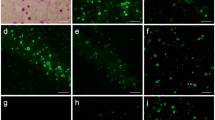Abstract
The peripheral part of the olfactory system (bulb and tract) was investigated for the occurrence of corpus amylaceum (CA) (polyglucosan body) in 296 (281 pathological and 15 control) autopsied human brains. No significant differences were found respect to the incidence between the various age groups above 40 or between the different disease groups and the controls. The predominance of CA in the olfactory tract and its loose correlation with the over 40 age group at this localization could be, the result of various factors, including the extremely rich astrocytic and capillary network in the intermediate zone, as well as the proximity of the olfactory tract to the external environment, which may result in the protective role of CA. The role of stress was proved by the HSP-60 positivity of CA.
Similar content being viewed by others
References
Austin JH, Sakai M: Corpora amylacea. In: Pathology of the Nervous System. Vol.3. (J Minckler, ed), McGraw-Hill Book. Co, New York, pp 2961–2968, 1972.
Carpenter MB: Human Neuroanatomy. Williams & Wilkins, Baltimore, 1976.
Cervós-Navarro L: Polyglukosaneinschlüsse im Nervengewebe. In: Pathologie des Nervensystems. V. (J Cervós-Navarro, ed.) Springer Verlag, Berlin, Heidelberg; pp 99–115, 1991.
Cissá S, Lacoste-Royal G, Laperrierre T, et al: Ubiquitin is a component of polypeptides purified from corpora amylacea of aged human brain. Neurochem Res 16:429–433, 1991.
Cissé S, Perry G, Lacoste-Royal G et al: Immunochemical identification of ubiquitin and heat-shock protein in corpora amylacea from normal aged and Alzheimer’s disease brains. Acta Neuropathol 85:233–240, 1993.
Cissé S, Schipper HM: Experimental induction of corpus amy- laceum-like inclusion in rat astroglia. Neuropathol Appl Neurobiol 21:423–431, 1996.
Hirano A. Some fine structural alterations of the central nervous system in aging. In Proc 7th Internat Congr Neuropathol (I Környey, I Tariska, Gy Gosztonyi, eds), Excerpta Med, Amsterdam, Akadémiai Kiadó, Budapest, pp 83–90, 1975.
Leel-Őssy L: The origin and the pathological significance of the corpus amylaceum. In: Experimental and Clinical Neuropathology. (K Jellinger, F Gullotta, M Mossakowski, eds), Acta Neuropathologica Suppl VII. 396–399, 1981.
Leel-Őssy L: The structure and pathological significance of corpus amylaceum. (In Hungarian) (L Leel-Õssy, ed.) Statisztikai Könyvkiadó. Budapest, pp 189–202, 1989.
Leel-Őssy L: Pathological significance and characteristics of corpus amylaceum. Neuropathology (Japan) 11:105–114, 1991.
Leel-Őssy L: Ultrastructural properties of corpus amylaceum. Abstr. Clin Neuropathol 11:179, 1992.
Leel-Őssy L: New observations in the study of corpus amylaceum (polyglucosan body). (In Hungarian) Ideggyögy Szemle 47:435–436, 1994.
Leel-Őssy L: The occurrence of corpus amylaceum (polyglucosan body) in diabetes mellitus. Neuropathology (Japan) 15:108–11, 1995.
Leel-Őssy L: Statistical evaluation and pathological significance of the occurrence of corpus amylaceum (Polyglucosan body). (In Hungarian) Ideggyógy Szemle 50:90–102, 1996.
Liu HM, Burns AC: Mucopolysaccharides in corpora amylacea in normal and diseased brains. J Neuropathol Exp Neurol 44:335, 1985.
Lowe J, Mayer RJ, Landon M: Ubiquitin in Neurodegenerative Diseases. Brain Pathology 3:55–65, 1993.
Paimucci L, Anzil AP, Luh S: Intra-astrocytic glycogen granules and corpora amylacea stain positively for polyglucosans: a cytochemical contribution on the fine structural polymorphism of particulate polysaccharides. Acta Neuropathol (Berl.) 57:99–102, 1982.
Roukema PA, Oderkerk CH: Isolation and preliminary characterization of corpora amylacea from human brain. Psychiat Neurol Neurochir 73:87–96, 1970.
Shingrao SK, Morgan AP, Neal JW, et al: A functional role for corpora amylacea found on evidence from complement studies. Neurodegeneration 4:335–346, 1996.
Steyaert A, Cissé S, Merhi Y et al: Purification and polypeptide composition of corpora amylacea from aged human brain. J Neurosci Methods 31:59–64, 1990.
Author information
Authors and Affiliations
Rights and permissions
About this article
Cite this article
Leel-Őssy, L., GÁti, I. Corpus amylaceum (Polyglucosan Body) in the peripheral olfactory system. Pathol. Oncol. Res. 4, 212–216 (1998). https://doi.org/10.1007/BF02905251
Received:
Accepted:
Issue Date:
DOI: https://doi.org/10.1007/BF02905251




